Millimeter-Wave High-Gain Dual-Polarized Flat Luneburg Lens Antenna with Reflection Cancellation
Abstract
1. Introduction
2. Performance Comparison between Conventional and Flat Luneburg Lens
3. Flat Luneburg Design and Implementation
3.1. Flat Luneburg Lens
3.2. Feeding Patch Antenna
3.3. Reflection Cancellation Method
3.4. Dual-Polarized FLLA
4. Implementation, Measurements and Discussions
4.1. Implementation of FLLA
4.2. Measurement of FLLA
4.3. Discussion
5. Conclusions
Author Contributions
Funding
Institutional Review Board Statement
Informed Consent Statement
Data Availability Statement
Acknowledgments
Conflicts of Interest
References
- Hong, W.; Jiang, Z.H.; Yu, C.; Zhou, J.; Chen, P.; Yu, Z.; Zhang, H.; Yang, B.; Pang, X.; Jiang, M.; et al. Multibeam antenna technologies for 5G wireless communications. IEEE Trans. Antennas Propag. 2017, 65, 6231–6249. [Google Scholar] [CrossRef]
- Hemadeh, I.A.; Satyanarayana, K.; El-Hajjar, M.; Hanzo, L. Millimeter-wave communications: Physical channel models design considerations antenna constructions and link-budget. IEEE Commun. Surv. Tuts. 2018, 20, 870–913. [Google Scholar] [CrossRef]
- Osseiran, A.; Boccardi, F.; Braun, V.; Kusume, K.; Marsch, P.; Maternia, M.; Queseth, O.; Schellmann, M.; Schotten, H.; Taoka, H.; et al. Scenarios for 5G mobile and wireless communications: The vision of the METIS project. IEEE Commun. Mag. 2014, 52, 26–35. [Google Scholar] [CrossRef]
- He, S.; Zhang, Y.; Wang, J.; Zhang, J.; Ren, J.; Zhang, Y.; Zhuang, W.; Shen, X. A survey of millimeter-wave communication: Physical-layer technology specifications and enabling transmission technologies. Proc. IEEE 2021, 109, 1666–1705. [Google Scholar] [CrossRef]
- Mosallaei, H.; Rahmat-Samii, Y. Non-uniform Luneburg and two shell lens antennas: Radiation characteristics and design optimization. IEEE Trans. Antennas Propag. 2001, 49, 60–69. [Google Scholar] [CrossRef]
- Yang, J.; Li, N.; Ma, P.; Liu, B. Calibration of Radar RCS Measurement Errors by Observing the Luneburg Lens Onboard the LEO Satellite. Sensors 2022, 22, 5421. [Google Scholar] [CrossRef]
- Liang, M.; Ng, W.R.; Chang, K.; Gbele, K.; Gehm, M.E.; Xin, H. A 3-D Luneburg lens antenna fabricated by polymer jetting rapid prototyping. IEEE Trans. Antennas Propag. 2014, 62, 1799–1807. [Google Scholar] [CrossRef]
- Sayanskiy, A.; Glybovski, S.; Akimov, V.P.; Filonov, D.; Belov, P.; Meshkovskiy, I. Broadband 3-D Luneburg lenses based on metamaterials of radially diverging dielectric rods. IEEE Antenna Wirel. Propag. Lett. 2017, 16, 1520–1523. [Google Scholar] [CrossRef]
- Fuchs, B.; Coq, L.L.; Lafond, O.; Rondineau, S.; Himdi, M. Design optimization of multi-shell Luneburg lenses. IEEE Trans. Antennas Propag. 2007, 55, 283–289. [Google Scholar] [CrossRef]
- Lian, J.-W.; Ansari, M.; Hu, P.; Guo, Y.J.; Ding, D. Wideband and high-efficiency parallel-plate Luneburg lens employing all-metal metamaterial for multibeam antenna applications. IEEE Trans. Antennas Propag. 2023, 71, 3193–3203. [Google Scholar] [CrossRef]
- Lu, H.; Liu, Z.; Liu, Y.; Ni, H.; Lv, X. Compact air-filled Luneburg lens antennas based on almost-parallel plate waveguide loaded with equal-sized metallic posts. IEEE Trans. Antennas Propag. 2019, 67, 6829–6838. [Google Scholar] [CrossRef]
- Hu, B.; Wu, T.; Cai, Y.; Zhang, W.; Zhang, B. A novel metamaterial-based planar integrated Luneburg lens antenna with wide bandwidth and high gain. IEEE Access 2020, 8, 4708–4713. [Google Scholar] [CrossRef]
- Liu, P.; Zhu, X.-W.; Zhang, Y.; Jiang, Z.H.; Wang, X.; Hong, W.; Le, T.H. A novel E-plane-focused cylindrical Luneburg lens loaded with metal grids for sidelobe level reduction. IEEE Trans. Antennas Propag. 2020, 68, 736–744. [Google Scholar] [CrossRef]
- Luo, Y.; Ji, R.; Zhang, Y. Performance analysis of planar Luneburg lens and full dielectric lens. In Proceedings of the 2022 IEEE 10th Asia-Pacific Conference on Antennas and Propagation (APCAP), Xiamen, China, 14–16 November 2022. [Google Scholar]
- Quevedo-Teruel, O.; Tang, W.; Hao, Y. Isotropic and nondispersive planar fed Lüneburg lens from Hamiltonian transformation optics. Opt. Lett. 2012, 37, 4850–4852. [Google Scholar] [CrossRef]
- Wu, L.; Tian, X.; Ma, H.; Yin, M.; Li, D. Broadband flattened Lüneburg lens with ultra-wide angle based on a liquid medium. Appl. Phys. Lett. 2013, 102, 074103. [Google Scholar] [CrossRef]
- Wan, X.; Jiang, W.X.; Ma, H.F.; Cui, T.J. A broadband transformation-optics metasurface lens. Appl. Phys. Lett. 2014, 104, 151601. [Google Scholar] [CrossRef]
- Ma, H.F.; Cui, T.J. Three-dimensional broadband and broad angle transformation-optics lens. Nat. Commun. 2010, 1, 124. [Google Scholar] [CrossRef]
- Mateo-Segura, C.; Dyke, A.; Dyke, H.; Haq, S.; Hao, Y. Flat Lüneburg lens via transformation optics for directive antenna applications. IEEE Trans. Antennas Propag. 2014, 62, 1945–1953. [Google Scholar] [CrossRef]
- Su, Y.; Chen, Z.N. A flat dual-polarized transformation-optics beamscanning Luneburg lens antenna using PCB-stacked gradient index metamaterials. IEEE Trans. Antennas Propag. 2018, 66, 5088–5097. [Google Scholar] [CrossRef]
- Su, Y.; Chen, Z.N. A radial transformation-optics mapping for flat ultra-wide-angle dual-polarized stacked GRIN MTM Luneburg lens antenna. IEEE Trans. Antennas Propag. 2019, 67, 2961–2970. [Google Scholar] [CrossRef]
- Xu, R.; Chen, Z.N. A transformation-optics-based flat metamaterial Luneburg lens antenna with zero focal length. IEEE Trans. Antennas Propag. 2022, 70, 3287–3296. [Google Scholar] [CrossRef]
- Munk, B. Finit Antenna Arrays and FSS; Wiley-IEEE: Hoboken, NJ, USA, 2003. [Google Scholar]

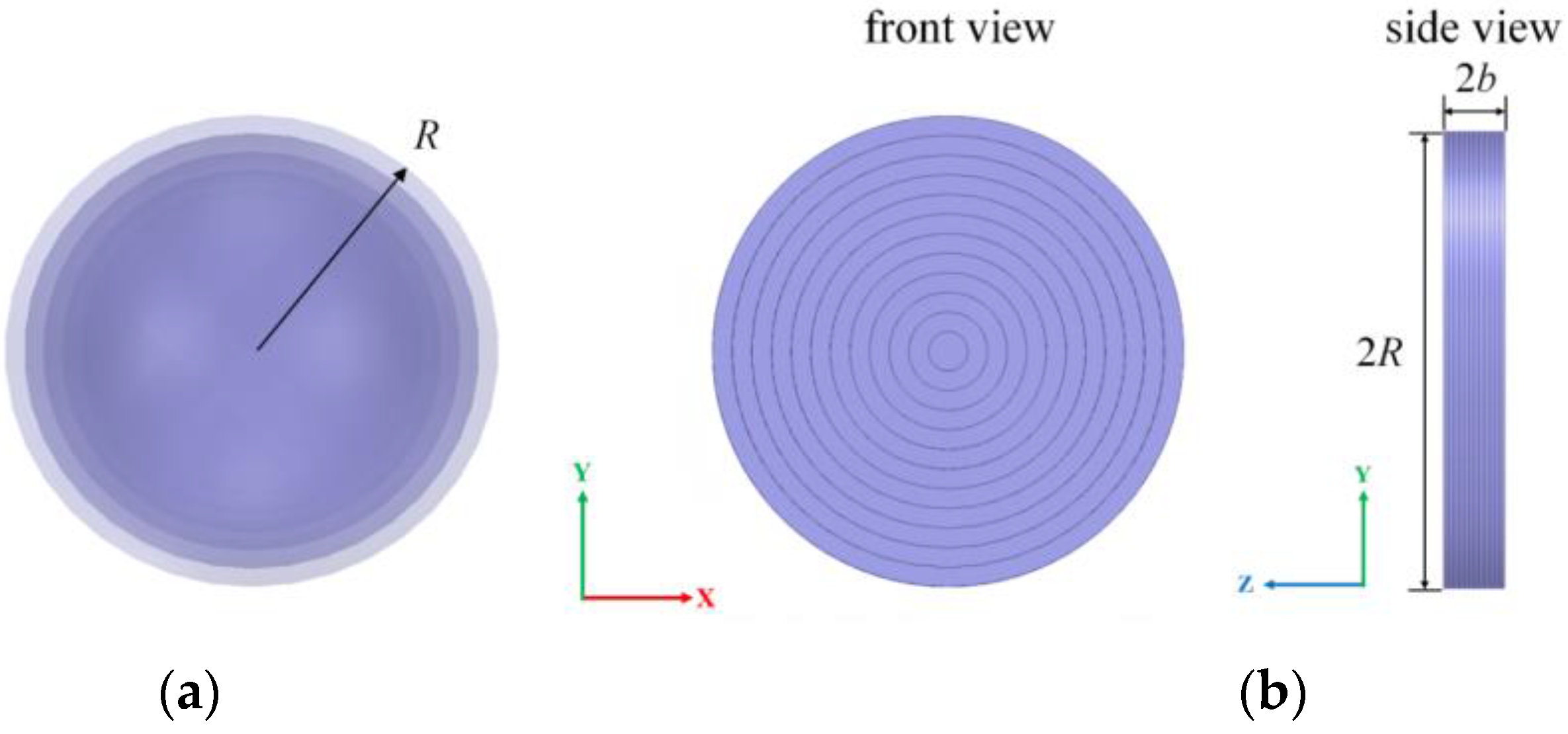
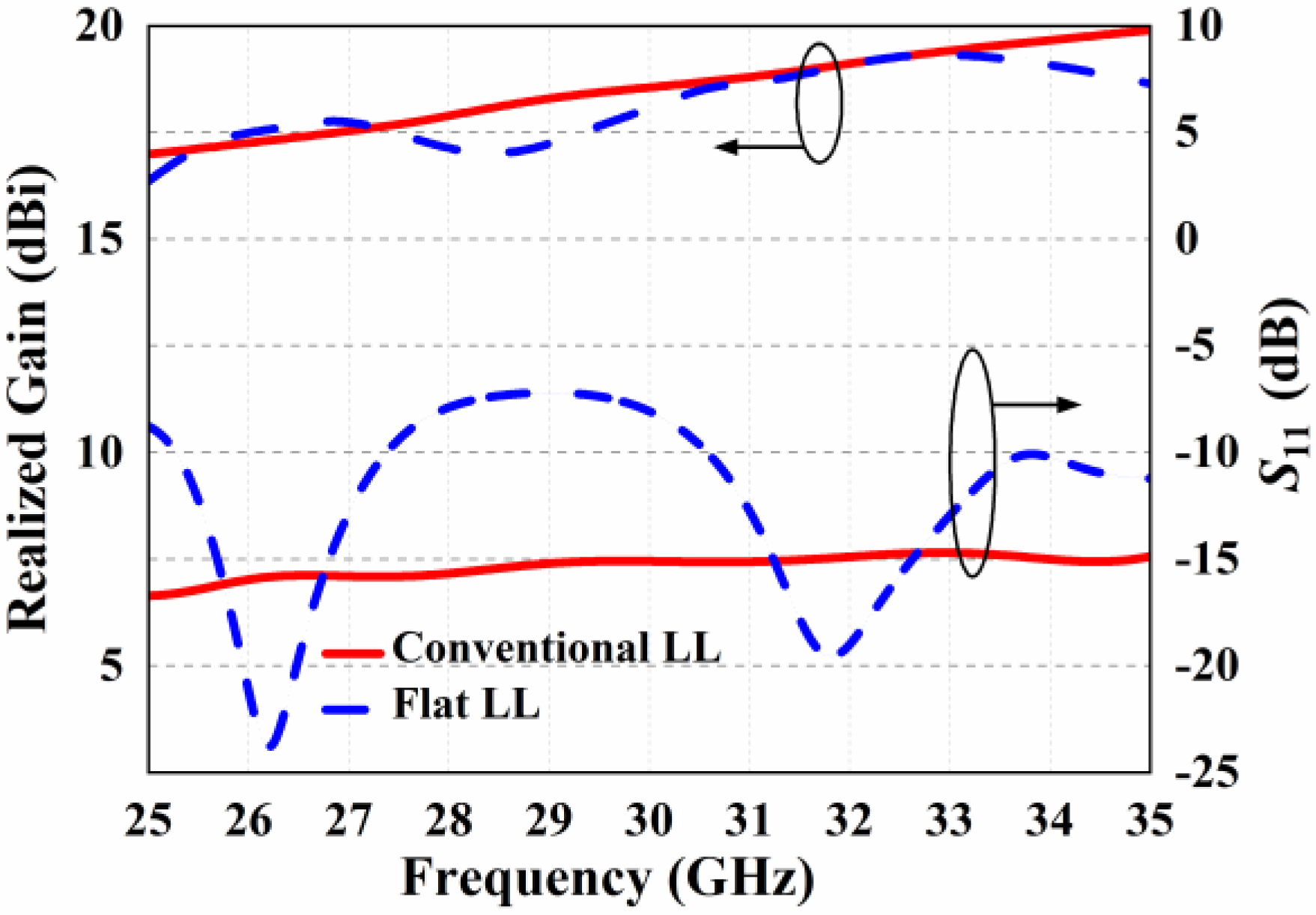


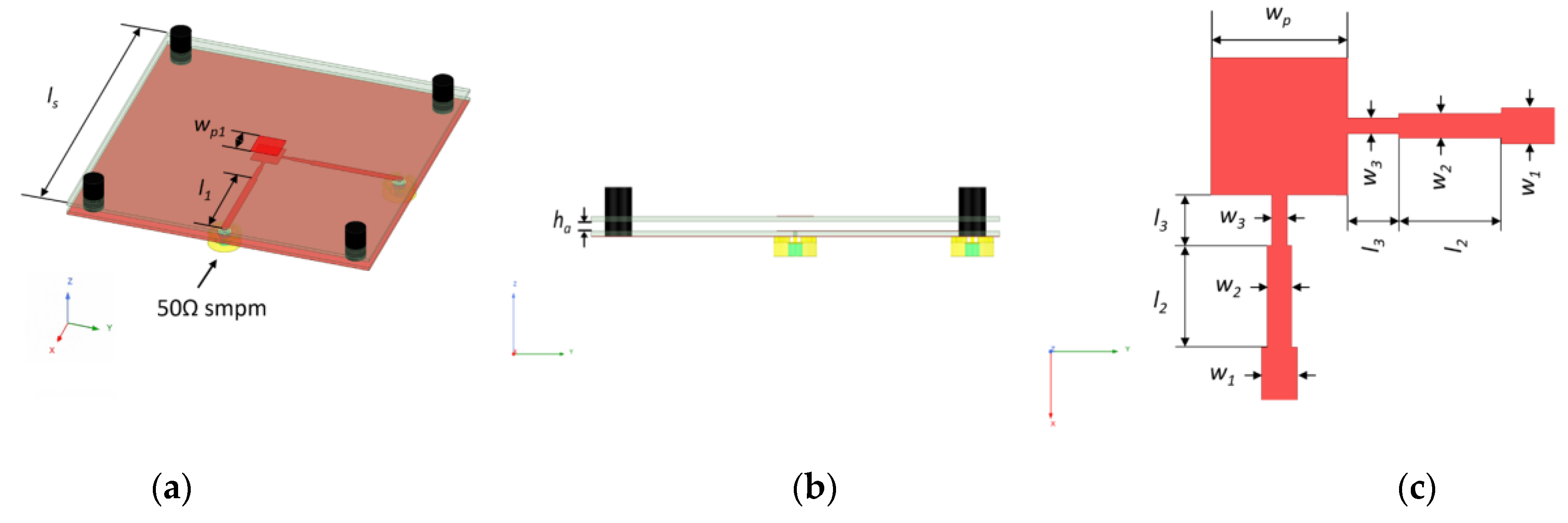
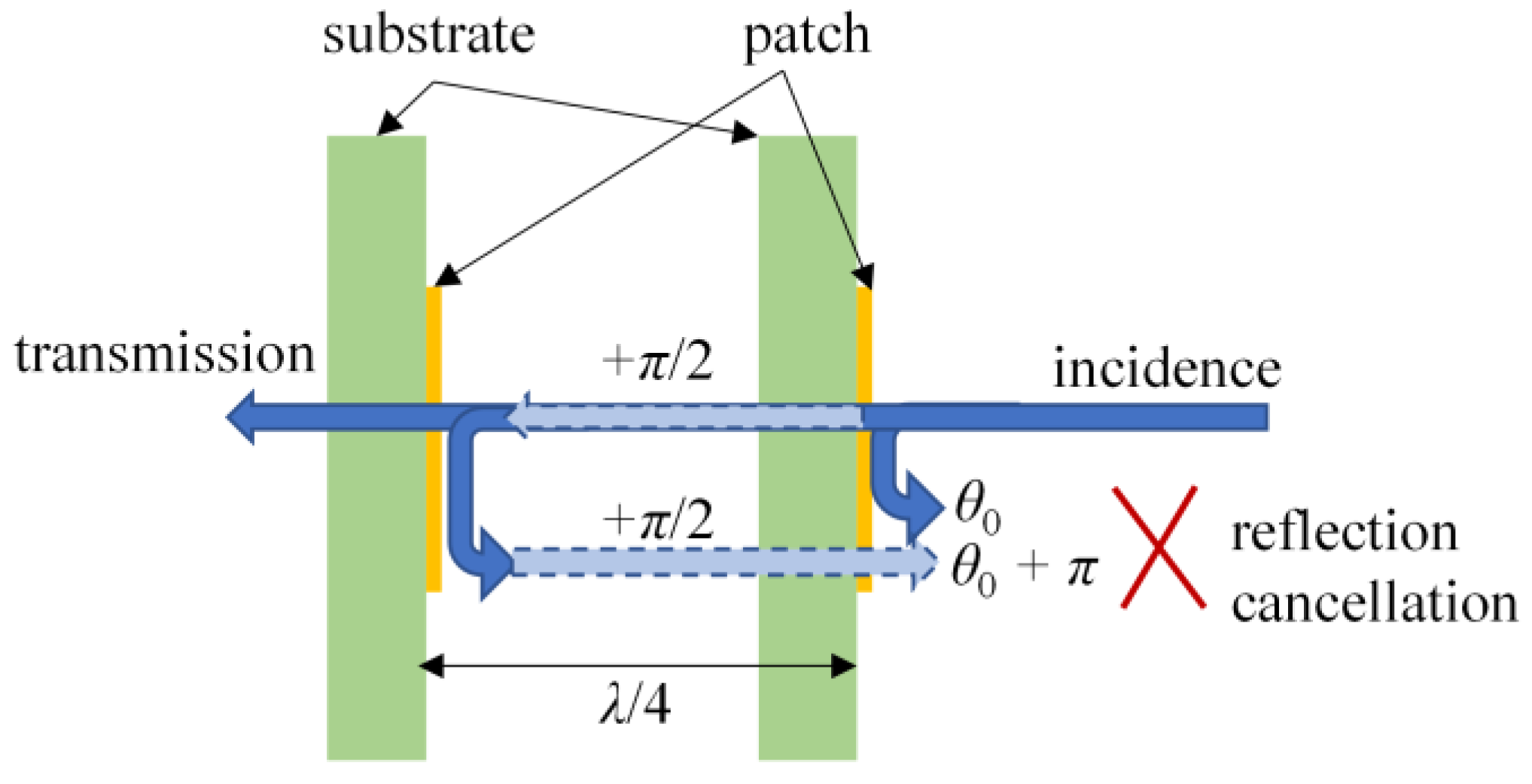
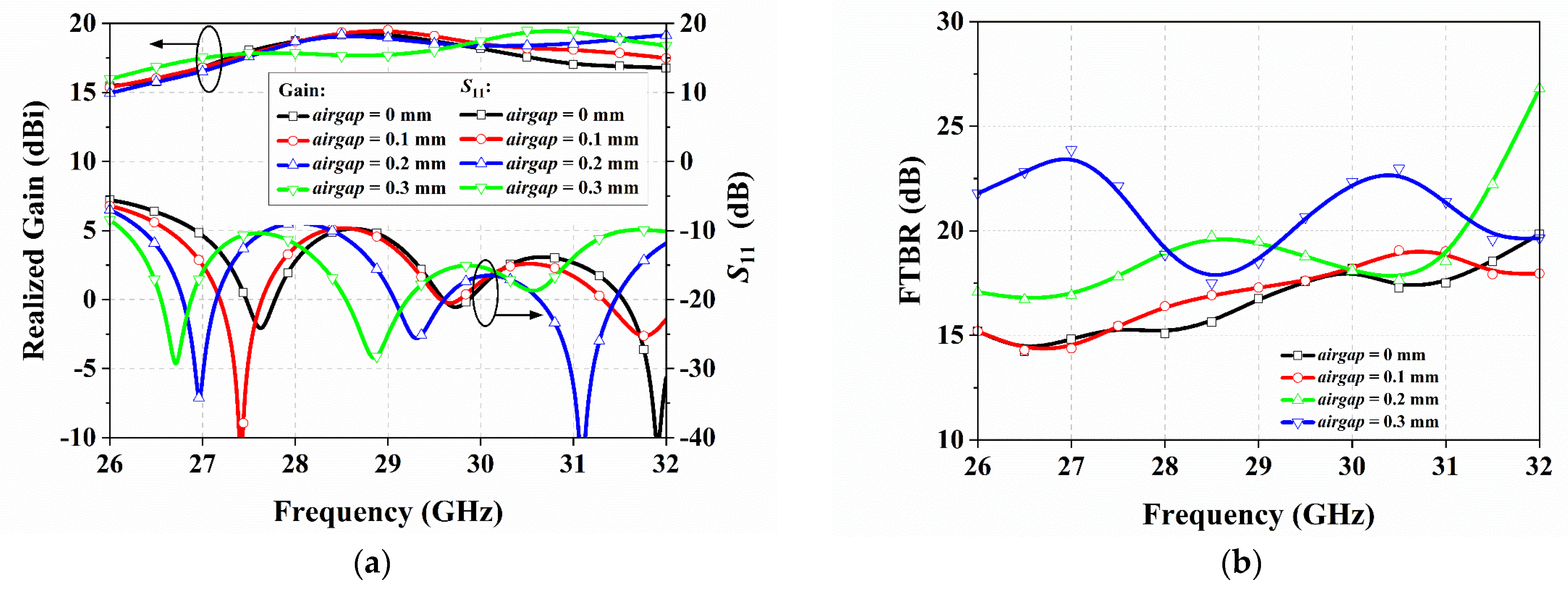
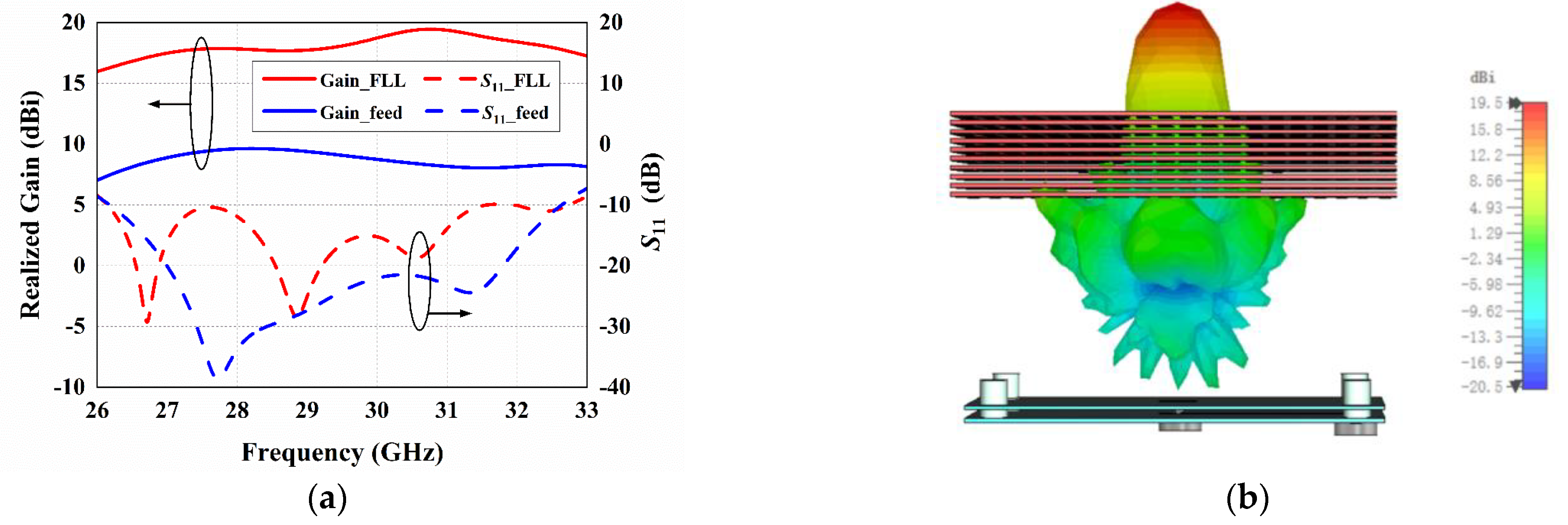


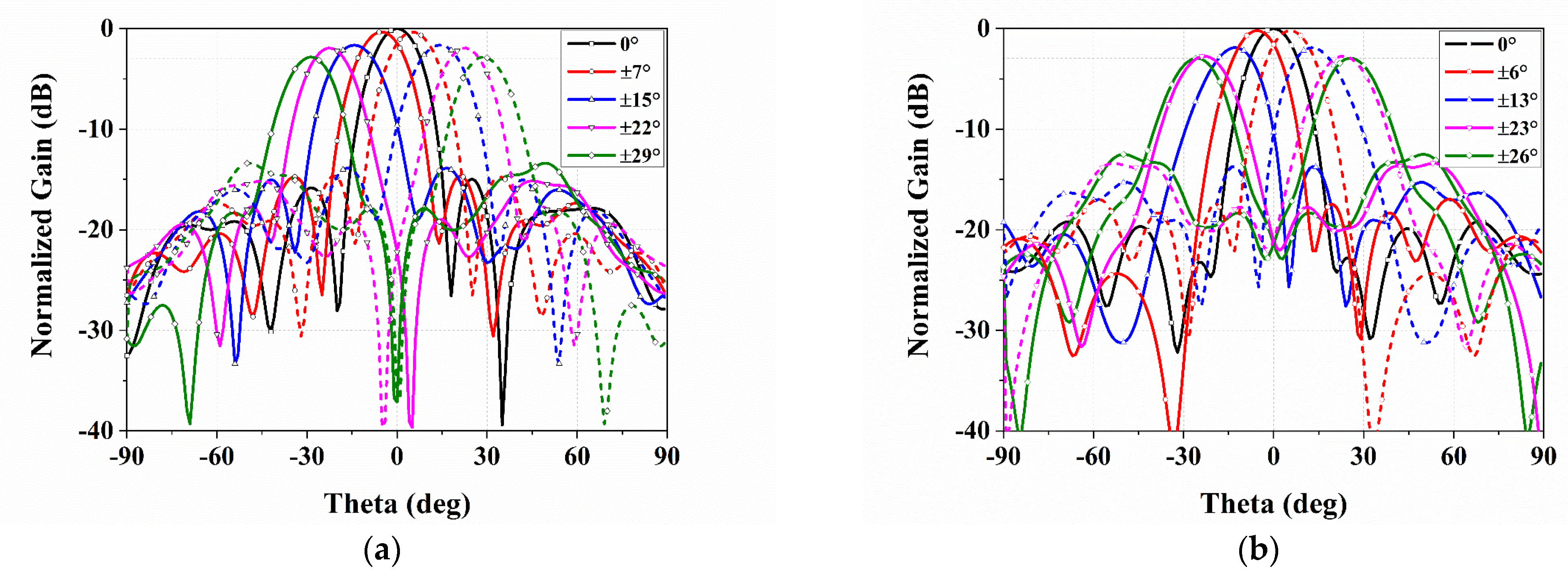
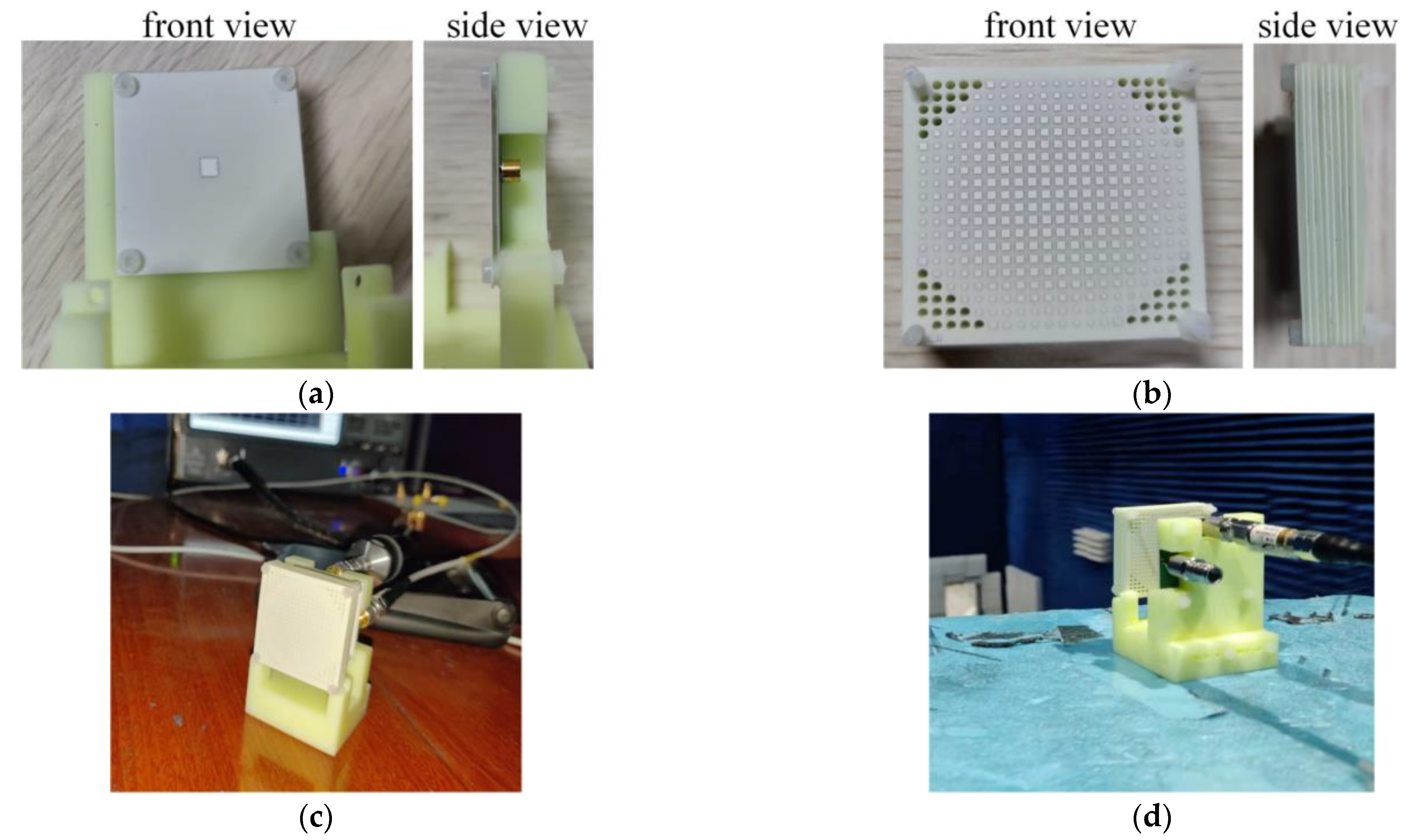
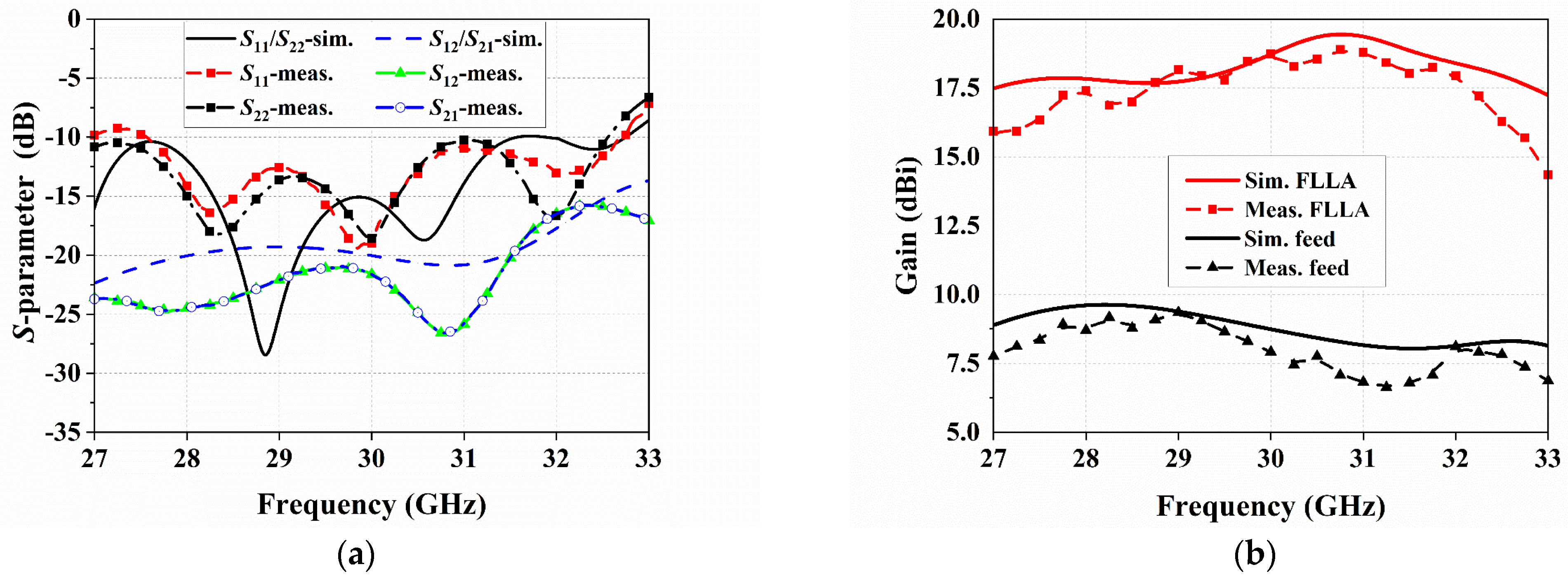
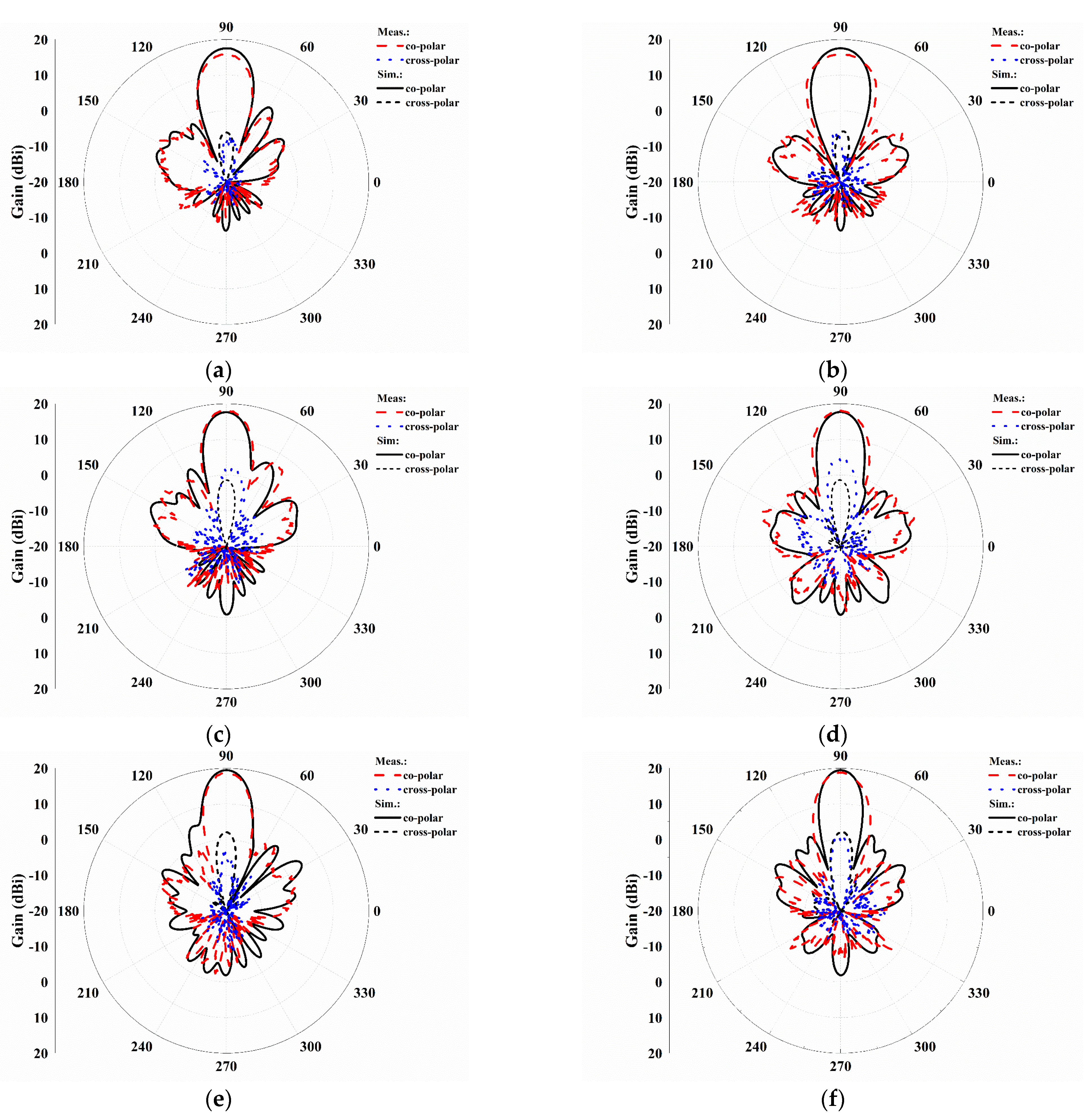

| Performance | Spherical LL # (in This Work) | FLL in [13] | FLL in [20] | FLL in [21] | This Work |
|---|---|---|---|---|---|
| Operating freq. (GHz) | 29 | 26 | 10 | 10 | 29 |
| Electrical size (λ at central freq.) | (4π/3) × 293 | π × (3.82)2 × 1.73 | 3.29 × 3.29 × 0.47 | 3.14 × 3.14 × 0.5 | 3.1 × 3.1 × 0.56 |
| Number of layers | 12 | 6 | 17 | 18 | 10 |
| Fract. bandwidth | >33% | ~17.3 ⁕ | 21% | 20% | 17.6% |
| Comparison ratio (R/b) | None | 2.2 | 6.87 | 6.28 | 5.56 |
| Gain(dB) | 18.1 @ 31 GHz | 17.4 @ 26 GHz | 15.88/16.35 @10 GHz | 13/13.2 @10 GHz | 18.88/18.67 @ 30.8 GHz |
| Polarization | dual pol. | single pol. | dual pol. | dual pol. | dual pol. |
| Scanning angle (gain loss) | 2D full angle | 1D full angle | ±32° (~2.5 dB ⁕)/ ±35° (~2 dB ⁕) | ±54° (0.7 dB)/ ±54° (2.2 dB) | ±25° (1.72 dB)/ ±24° (1.7 dB) |
| FTBR (dB) | 26 | ~17.5 ⁕ | 10 | 10 | 19.5 |
| X-pol. level (dB) | −40 | −20 | −17 | −15 | −15 |
| Aperture efficiency | -- | -- | 46.2% | 21.2% | 81.7% |
Disclaimer/Publisher’s Note: The statements, opinions and data contained in all publications are solely those of the individual author(s) and contributor(s) and not of MDPI and/or the editor(s). MDPI and/or the editor(s) disclaim responsibility for any injury to people or property resulting from any ideas, methods, instructions or products referred to in the content. |
© 2023 by the authors. Licensee MDPI, Basel, Switzerland. This article is an open access article distributed under the terms and conditions of the Creative Commons Attribution (CC BY) license (https://creativecommons.org/licenses/by/4.0/).
Share and Cite
Zhang, Y.; Luo, Y.; Ji, R. Millimeter-Wave High-Gain Dual-Polarized Flat Luneburg Lens Antenna with Reflection Cancellation. Appl. Sci. 2023, 13, 6468. https://doi.org/10.3390/app13116468
Zhang Y, Luo Y, Ji R. Millimeter-Wave High-Gain Dual-Polarized Flat Luneburg Lens Antenna with Reflection Cancellation. Applied Sciences. 2023; 13(11):6468. https://doi.org/10.3390/app13116468
Chicago/Turabian StyleZhang, Yan, Yinsen Luo, and Ran Ji. 2023. "Millimeter-Wave High-Gain Dual-Polarized Flat Luneburg Lens Antenna with Reflection Cancellation" Applied Sciences 13, no. 11: 6468. https://doi.org/10.3390/app13116468
APA StyleZhang, Y., Luo, Y., & Ji, R. (2023). Millimeter-Wave High-Gain Dual-Polarized Flat Luneburg Lens Antenna with Reflection Cancellation. Applied Sciences, 13(11), 6468. https://doi.org/10.3390/app13116468





